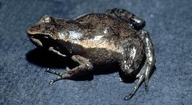|
Hyloxalus sylvaticus (Barbour & Noble, 1920)
| family: Dendrobatidae subfamily: Hyloxalinae genus: Hyloxalus |
 © 2004 Natural History Museum and Biodiversity Research Center, The University of Kansas (1 of 1) |
|
|
|
Description Males of this relatively large species of Hyloxalus attain a snout-vent length of 25.7 mm and females, 30.0 mm. The discs on the fingers and toes are barely wider than the penultimate phalanges. Finger I is equal in length to Finger II, and Finger III is not swollen in males. Lateral fringes are present on the fingers and toes. An inner tarsal fold usually is present; the toes are unwebbed. The dorsum is olive brown to coppery brown with dark brown to black flecks; the digital scutes are pale gray, contrasting to the adjacent dark grayish brown surfaces. The upper lips and dorsolateral stripes are creamy tan to pale bronze; oblique lateral and ventrolateral stripes are absent. The throat, posterior part of belly, and ventral surfaces of the hind limbs dark yellow to orange; the chest and anterior part of the belly are gray with black flecks. The iris is dull bronze with black flecks. A median lingual process is absent, and the testes are white (Barbour and Noble 1920). A tadpole in Stage 33 has a body length of 13.0 mm and a total length of 29.4 mm. The body is ovoid and wider than high. The snout is depressed, acutely rounded in dorsal view, and rounded in profile. The small eyes are situated dorsally, directed dorsolaterally, and not visible from below. The spiracle is sinistral with a short tube that is attached to body wall; the spiracular opening is directed posteriorly well below the midline at about two-fifths of the length of the body. The cloacal tube is short, dextral, and attached to the ventral fin. The caudal musculature is moderately robust, about equal in height throughout the proximal half of the tail, and then diminishes gradually to a pointed terminus short of tip of the tail. The dorsal fin originates on the proximal base of the caudal musculature, is highest at about two-thirds of the length of the tail, and diminishes to a bluntly rounded tip; the ventral fin originates on the body wall and is highest at midlength of tail. The oral disc is directed anteroventrally. The median half of the upper labium is bare; elsewhere the labia bear a single row of moderately large subconical marginal papillae, but some individuals have two rows laterally. The jaw sheaths are moderately robust and finely serrate; the anterior sheath forms a broad arch, and the posterior sheath is widely V-shaped. The labial tooth row formula is 2/3(1); the anterior rows are slightly longer than the posterior rows, and P3 is the shortest. The body and tail are olive-tan with green lichenous markings dorsally on the caudal musculature. The belly is greenish white; edge of the oral disc is yellow, and the iris is pale bronze. Distribution and Habitat Country distribution from AmphibiaWeb's database: Peru
Life History, Abundance, Activity, and Special Behaviors
References
Barbour, T., and Noble, G. K. (1920). ''Some amphibians from northwestern Peru, with a revision of the genera Phyllobates and Telmatobius.'' Bulletin of the Museum of Comparative Zoology, Harvard University, 63, 395-427. Duellman, W. E. (2004). ''Frogs of the genus Colostethus (Anura; Dendrobatidae) in the Andes of northern Peru.'' Scientific Papers of the Natural History Museum, University of Kansas, 35, 1-49. Originally submitted by: William Duellman (first posted 2004-12-10) Edited by: Kellie Whittaker (2007-12-03) Species Account Citation: AmphibiaWeb 2007 Hyloxalus sylvaticus <https://amphibiaweb.org/species/1613> University of California, Berkeley, CA, USA. Accessed Apr 19, 2024.
Feedback or comments about this page.
Citation: AmphibiaWeb. 2024. <https://amphibiaweb.org> University of California, Berkeley, CA, USA. Accessed 19 Apr 2024. AmphibiaWeb's policy on data use. |


 Map of Life
Map of Life